by Winding Pathways | Nov 21, 2019 | (Sub)Urban Homesteading, Birds, Foraging, Garden/Yard, Nature, Trees
A New World Thanksgiving
Almost every meal Americans enjoy comes from animals and plants that trace their origin to many continents.
Cattle, sheep, chickens, and pigs, for example, are all natives of the Old World brought to America soon after it was settled by Europeans. Wheat, rice, and many other plant foods are also newcomers that were unknown to Native Americans.
One annual feast mostly made from original American foods is Thanksgiving. This year why not create this traditional feast from entirely plants and animals that were found here before Columbus?
Turkeys
Turkey highlights the Thanksgiving dinner. See our previous blog on this amazing and tasty bird. Here are plants native to North and South America to complement roast turkey:
Fruits and Vegetables
Corn: Corn has been grown in Central America for thousands of years. It’s cultivation gradually spread north and east and became a staple food for Native Americans. When hungry Pilgrims landed in what became Massachusetts they found and stole caches of corn stored by local tribes, no doubt causing bad feelings.
Cranberries: Most commonly eaten fruits originated in Europe or Asia, but the cranberry is an American native.
Squash and Pumpkins: Dozens of varieties of winter squash come in many shapes, colors and sizes, and the pumpkin is actually a squash. Butternut, Hubbard, acorn, or any other squash is delicious on the Thanksgiving dinner table, and dessert of pumpkin pie rounds out a tasty meal.
Potatoes: Common potatoes also originated in South or Central America and have been an important food for thousands of years. Mashed or baked, they go well with turkey, squash, and cranberries.
Sweet Potatoes: Originally from South America, these are among the most nutritious of foods. Similar yams have an African origin, so for a local dinner stick with sweet potatoes.
The sweetness from the Maples
Maple Syrup: While honey is made by bees that came from the Old World, maple syrup is America’s sweetener. It’s delicious on squash or sweet potatoes.
Beans: Native American gardens usually featured three plants: beans, squash, and corn. Commonly called The Three Sisters combined they create a balanced diet.
A diet of many foods that originally came from the Americas makes a delicious an interesting Holiday meal. We tend to thank modern geneticists for creating abundant food, but beans, corn, squash, sweet potatoes, maple syrup, cranberries, and turkey were all domesticated and enjoyed by Native Americans long before Columbus set sail.
-

-
Cranberry Pie brightens any Thanksgiving table.
-
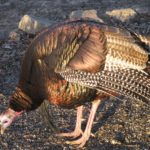
-
Cook Wild turkey differently than domesticated ones.
-
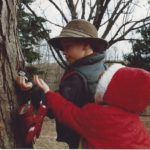
-
Maple syrup can sweeten many Thanksgiving meals.
by Winding Pathways | Nov 7, 2019 | Nature, Travel/Columns, Trees
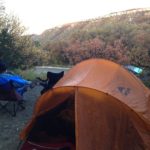
Enjoying Iowa’s forests.
Iowa is one of the states with the fewest trees, yet in the late 1800s we were the Lumber Kings of the World! And,

Notice the tree rings on this wide board from New Hampshire
Clinton, Iowa’s minor league baseball team proudly retains that name – Lumber Kings! Why? Read The Green Gazette (9-29-2019, Living L-09 and 10) to learn about Iowa’s forest industry, where you can camp today in quiet forests and how lumbering put Clinton, Iowa, on the map.
by Winding Pathways | Oct 31, 2019 | Bugs, Garden/Yard, Nature
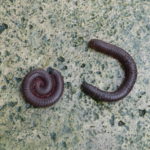
Millipedes are ancient creatures
Many people discovered one of the oldest types of animals in their yards and homes this year. Millipedes. Usually common they have been especially visible in this humid rainy summer and fall.
Millipedes have been around for millions of years doing the world a service. Biologists call them detritivores, which simply means they eat bits of decaying leaves, grass, feces, and other organic matter found nearly everywhere. Scientists call dead material of many origins detritus. To millipedes it’s dinner.
About 12,000 species of millipedes live around the world on all continents except Antarctica. They range from about a quarter-inch to several inches long and most are brown or black. All have two pairs of legs on each body segment. Since they have many segments millipedes have enormous numbers of legs stretching down each side of their body. That doesn’t make them speedsters. Millipedes creep along.
Few animals are as harmless as millipedes. They can’t bite or sting. When threatened millipedes roll up in a ball and play possum, but normally they avoid predators by hiding in detritus or under rocks and logs. Snakes, amphibians, and birds enjoy snacking on them.
Millipedes are sometimes confused with centipedes, but they are distinctly different. Millipedes are sluggish consumers of dead plants while centipedes are swift predators. Both enter homes through cracks and holes in the walls or gaps in doors and windows. Caulking is an effective way to keep them outside.
Millipedes may seem creepy to some people but they have survived for millions of years recycling dead plant material into humus. They deserve our respect.
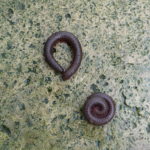
Can you count the millipede legs?
Answer: Millipedes take so long to lace up their shoes that the race is over by the time they finish.
by Winding Pathways | Oct 10, 2019 | Nature, Travel/Columns
Guest Blogger Paula Lelansky
My husband and I recently returned from an Alaskan vacation. This is a beautiful place to add to your bucket list! One of the first things I noticed was the clean, fresh air, and then the seemingly unspoiled beauty of Alaska! No matter where we were – in town, the forest or at Denali. The views were breathtaking. Traveling through Denali National Park, we were able to see that “the mountain was out.” This is the locals’ term for being able to see Mt. Denali in all its splendor without cloud cover.
Traveling the White Pass trail to the Summit, blazed by workers in the late 1800s, we marveled at the harsh conditions with which they must have dealt. Taking a kayak paddle near Hoonah, we watched a humpback whale right in front of us – spouting and breaching! We were saddened at seeing the devastation caused by the McKinley wildfire – one of three throughout Alaska this summer.
Sailing near Hubbard Glacier, with its beautiful hues of green and blue, we watched as it “calved” – a chunk of the Glacier falling off. Visiting at a dog sled camp and holding the puppies lifted our spirits! Taking a hike through the Tongass National Rainforest, the serene beauty took my breath away. We were enveloped by so much beautiful plant life in the forest. Fireweed, Devils Club and Horsetail, both with medicinal benefits, were abundant. Many different types of mosses, beautiful old towering hemlock and spruce trees, and muskegs (bogs) enchanted us. At a river, a black bear was attempting to catch salmon. After failing, she and her cub decided to follow the river downstream.
The experiences we had in Alaska will always stay with us. I’m ready to go back and spend more time exploring!
A mention about climate change. Due to the extremes in Alaska, climate change is most noticeable there. Glaciers and permafrost are melting rapidly. Hotter temperatures carry into the autumn. Unfortunately, logging in some areas is being considered. A warning to us all to be more mindful of how we live and use resources.
-
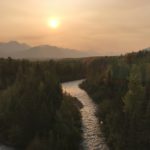
-
On train-land tour to Denali
-

-
Captivating blue-green of the glacier
-

-
Sailing from Juneau to Skagway.
-
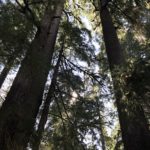
-
Ketchikan – Tongass Rainforest (20)
by Winding Pathways | Sep 19, 2019 | (Sub)Urban Homesteading, Foraging, Nature, Trees
Delicious, Erratic Acorns
Our back deck at Winding Pathways is an outstanding vantage point for watching butterflies, birds, and even our evening aerialist bats. The deck is perched over a deep, cool ravine with a stately black oak hovering above. That can be a problem.
In most autumns our black oak cascades acorns down to the ground and our deck. Removing them takes aggressive sweeping. Despite the hassle we love acorns.
Acorns are, of course, the seeds of oak trees. Hundreds of oak species live across much of the northern hemisphere. They can be a little tricky to identify since oaks sometimes hybridize and look like a blend of two or more species. Many people use leaf shape to identify trees, but oaks may throw a curve. Often leaves, called sun leaves, up on the top of an individual tree are smaller and may have a somewhat different shape than those down lower on the same tree. It can be confusing.
There are two general oak types, the white and red oak groups. White oak type trees include species commonly called white, swamp white bur (sometimes spelled burr), chinkapin also spelled chinquapin, and chestnut oaks. Their leaves have rounded lobes and they produce large acorns with low acid content. Red oak type trees include species commonly called red, black, and pin oaks. Their leaves have pointed lobes and their acorns are usually small and laden with bitter acid.
-
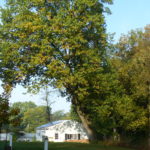
-
Acorns from the black Oak are small and bitter.
-
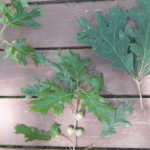
-
Oaks have different shaped leaves
-
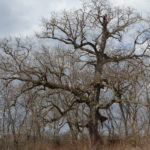
-
Century Oak Tree
-
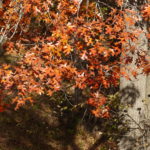
-
Oak leaves turn russet in autumn.
Acorns
Acorns are nature’s gift to many wildlife species and people. Few seeds are as abundant, large, and nutritious as acorns. Squirrels, chipmunks, muskrats, woodchucks, deer, bears, blue jays, wild turkeys, and a host of other animals gorge on them. The calorie-rich nuts help wildlife put on fat that helps them survive the coming winter.
But, there’s a problem. Oaks are erratic acorn producers. As a general rule, the white oak types only create a heavy crop every few years. Red oak type trees are more reliable but still sometimes skip a year of seed production. Sometimes few oaks in a vast area will produce acorns while an individual tree here and there will be loaded. Find a heavy acorn bearer in a scare year and you’ll have the company of many animals feeding on the nutritious nuts. Part of the reason for erratic crops stems from pollination. Oaks are wind-pollinated and a long spell of rain when they bloom in the spring can dampen pollination and eliminate a crop that autumn.
-
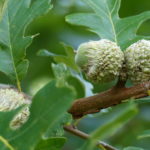
-
Acorns set up in the spring
-
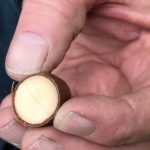
-
The white meat of an acorn.
-
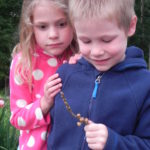
-
Two kids check out the acorns on a branch
-
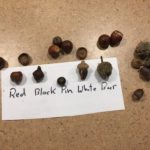
-
Iowa has many types of oaks
Acorns are a delicious human food that was relished by native people across the globe. To learn more about acorns and how to process them into food check out the Winding Pathways blog of August 2014 called Delicious Acorns.
by Winding Pathways | Sep 12, 2019 | Birds, Nature
Swapping Birds
All summer we’ve watched and listened to wren couples who built nests and raised young in our yard. An Indigo Bunting welcomed each summer morning with his song and serenaded the evening until dark. Early this spring, we marveled at the brilliantly colored orioles and grosbeaks who visited. During warm months, hummingbirds flitted up and down and all around outside our windows.
When a long-absent bird suddenly makes its springtime appearance in full breeding color, it’s exciting and easy to spot. We greet spring’s migrants after their long journey north with a hearty, “Welcome Home!” and some seed.
With fall now in the air, our vivacious summer bird friends are drifting away, pushed southward by vigorous north winds. Departure is different from arrival. When they appear in spring, birds are in their glorious mating colors and sing with gusto. They’ve been absent for months until one morning we look out the window – and there they are! It’s magical.
Indigo Buntings and Wrens Leave…
Arrivals are easy to mark. No so departures. By fall many birds have molted into their more subtle nonbreeding colors and just seem to evaporate. No singing marks their departure and figuring out just when they leave is challenging. More often we just say, “Gee, I haven’t heard the indigo buntings for a few days. I bet they’ve gone.”
…and Juncos Arrive
We wish we could help migrants on their departure evening by saying, “Have a safe trip and pleasant winter. See you next spring!” Since we don’t know exactly when they’ll be winging south, they depart without our good wishes. The parting is sad, but we know we’ll soon look out the window and almost miraculously spot the fall’s first juncos nosing around on the ground looking for a few seeds to enjoy for breakfast.
-
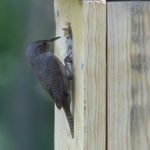
-
Wrens busily feed their young and sing all summer
-
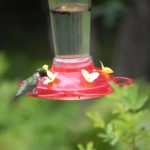
-
Hummingbirds zoom up, down, and sideways all summer. Then, head south.
-
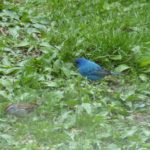
-
Indigo Bunting and Chipping Sparrow feeding.
Orioles and grosbeaks drift south starting in late summer and our bunting was gone by August 20. Hummingbirds and wrens disappear by late September. Juncos usually appear from northern breeding grounds in October and stick around until April. Then they seem to vanish overnight. But, that’s just before spring’s colorful songsters arrive






















